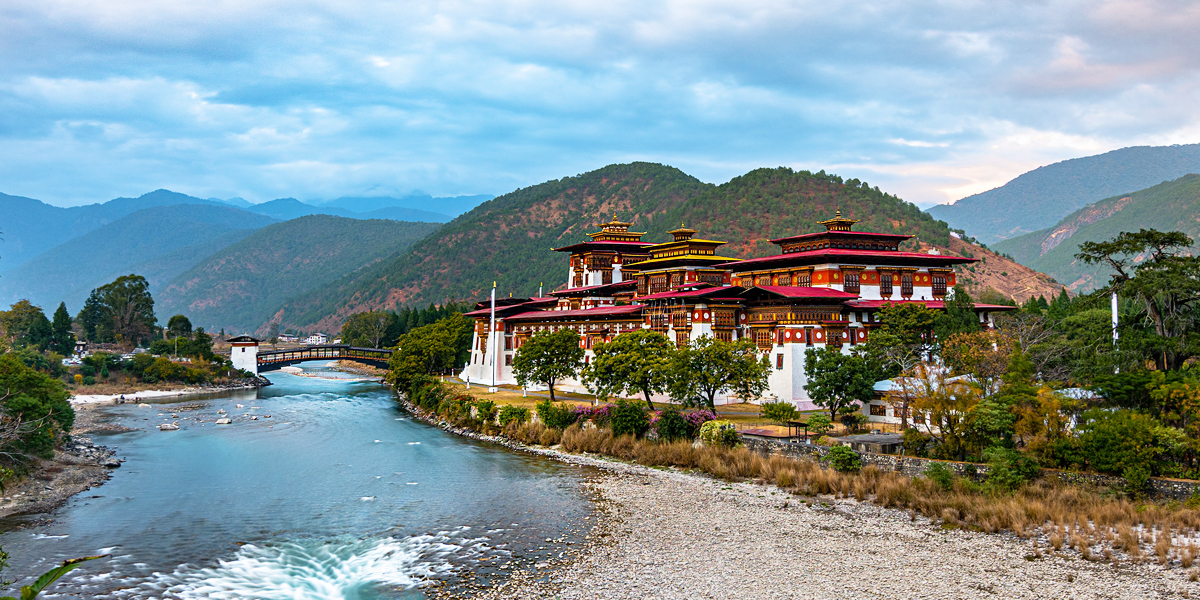About Bhutan
Beauty and spirituality are two elements without which Bhutan tourism is incomplete. Nestling in the mountainous regions of Eastern Himalayas, it offers pristine views of craggy mountains and verdant valleys.


The Kingdom of Bhutan is a small landlocked country located in the southern foothills of the Himalayan mountain range, sandwiched between the People's Republic of China in the north and the Republic of India in the south.
It is a sovereign nation, with a total land area of 38,394 km² and a total population of 735553 (2017).
An interesting fact about Bhutan - the general prosperity of the country is measured by the ‘Gross National Happiness’ index, explained by its four pillars - sustainable development, good governance, cultural preservation and environmental protection. Also, continually ranked as the happiest country in Asia and the eighth-happiest country in the world according to a survey by Business Week.
The climate in Bhutan is extremely varied, which can be attributed to two main factors-the vast differences in altitude present in the country and the influence of North Indian monsoons.
The country was originally known by many names including Lho Jong, ‘The Valleys of the South’, Lho Mon Kha Shi, ‘The Southern Mon Country of Four Approaches’, Lho Jong Men Jong, ‘The Southern Valleys of Medicinal Herbs and Lho Mon Tsenden Jong, ‘The Southern Mon Valleys where Sandlewood Grows’. Mon was a term used by the Tibetans to refer to Mongoloid, non-Buddhist peoples that populated the Southern Himalayas.
The country came to be known as Druk Yul or The Land of the Drukpas sometime in the 17th century. The name refers to the Drukpa sect of Buddhism that has been the dominant religion in the region since that period.
Initially Bonism (a pre-buddhist religion of Tibet) , was the dominant religion in the region that would come to be known as Bhutan. Buddhism was introduced in the 7th century by the Tibetan King Songtsen Gampo and was further strengthened by the arrival of Guru Rimpoche, a Buddhist Master that is widely considered to be the Second Buddha.
The country was first unified in 17th century by Zhabdrung Ngawang Namgyel. After arriving in Bhutan from Tibet he consolidated his power, defeated three Tibetan invasions and established a comprehensive system of law and governance. His system of rule eroded after his death and the country fell into in-fighting and civil war between the various local rulers. This continued until the Trongsa Penlop Ugyen Wangchuck was able to gain control and with the support of the people to establish himself as Bhutan’s first hereditary King in 1907. His Majesty Ugyen Wangchuck became the first Druk Gyalpo (Dragon King) and set up the Wangchuck Dynasty that still rules today.
In 2008 Bhutan enacted its Constitution and converted to a democracy in order to better safeguard the rights of its citizens. Later in November of the same year, the current reigning 5th Druk Gyalpo Jigme Khesar Namgyel Wangchuck was crowned.
The most distinctive characteristic of Bhutanese cuisine is its spiciness. Chillis are an essential part of nearly every dish and are considered so important that most Bhutanese people would not enjoy a meal that was not spicy.
Rice forms the main body of most Bhutanese meals. It is accompanied by one or two side dishes consisting of meat or vegetables. Pork, beef and chicken are the meats that are eaten most often. Vegetables commonly eaten include Spinach, pumpkins, turnips, radishes, tomatoes, river weed, onions and green beans. Grains such as rice, buckwheat and barley are also cultivated in various regions of the country depending on the local climate.
Gaze at this Buddhist monastery precariously perched on the side of a mountain hundreds of meters off of the ground. It’s worth the uphill hike to get here and this is your chance to see one of Bhutan’s most popular icons.
Most people spend at least a little time in this city since it is home to Paro International Airport. This is also your home base for the hike up to the Tiger’s Nest.
Thimphu is the capital of Bhutan. There is a lot to do here. Visit the Cheri Monastery, see the Takin Preserve, spin prayer wheels at the Memorial Chorten, or gaze up at Buddha Dordenma, the largest sitting Buddha in the world.
The Dochula Pass is a high mountain pass (3,150 meters, 10,330 ft) on the road between Thimpu and Punakha. Get a glimpse of snow-covered Himalayas and walk among the 108 chortens that serve as a memorial to Bhutanese soldiers killed in a uprising in 2003.
This city was once the capital of Bhutan. Visitors come here to see the amazing Punakha Dzong sitting on the banks of the Pho Chhu and Mo Chhu Rivers.
This is a Buddhist monastery located near Punakha. Lama Drukpa Kunley, the Divine Madman, is one of Bhutan’s favourite saints, famous for his sexual exploits. His temple is now visited by childless couples searching to increase their fertility. Be blessed by a wooden phallus to ward off evil spirits…a travel experience you won’t soon forget.
Thimphu which is the capital of Bhutan is the center of Bhutan shopping. A trip to the “Land of Happiness” would be incomplete without shopping in Bhutan. You can buy Thangkas, Handmade Kira & Gho, Hand-Woven Bamboo Items, Brassware, Carpets, finely Crafted Metal products, Woven Bags, Traditional Jewellery, Yak-bone Jewellery, Masks, Stoles, and Handmade Paper. Apart from Thimphu, Paro and Phuentsholing are good places to fulfill your shopping cravings.
September through November are the best months to visit Bhutan, with clear skies, pleasant temperatures, and the greatest number of festivals. Springtime, from March through May, are also good, with comfortable temperatures but a small chance of rain. The summer months, June through August, can be hot and this period gets the most rainfall. The winter months, December through February, have clear skies but cold temperatures and have the fewest tourists.
The only international airport in Bhutan is located at Paro, about an hour drive from Thimphu. Currently, two national airlines operate flights to Bhutan: Drukair and Bhutan Airlines. Departure points include Bangkok (Thailand), Kathmandu (Nepal), New Delhi and Kolkata (India), Dhaka (Bangladesh), Yangoon (Myanmar), and Singapore.
It's also possible to travel to Bhutan from India overland by road. The main border crossing is Jaigaon-Phuentsholing. There are two others, at Gelephu and Samdrup Jongkhar.

Book with Us and Get Best Deals in
*Terms and Conditions applied